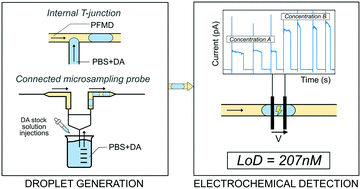In-flow electrochemical detection of chemicals in droplets with pyrolysed photoresist electrodes: application as a module for quantification of microsampled dopamine†
Abstract
The electrochemical quantification of analytes in droplets of PBS separated by a fluorinated phase was investigated. PDMS-fused silica chips with pyrolysed photoresist electrodes were prepared using a simple fabrication technique and used to analyze droplets in flow. Potentiostatic chronoamperometry provided current readouts consistent with mass transport and the concentration inside the droplets. This paper highlights measurements of dopamine in droplets in T-junction microfluidic chips at unprecedently low concentrations, with a limit of detection of 207 nM and a linear range of 0.21–20 μM, giving results similar to continuous flow electrochemistry and allowing the analysis in the striatal extracellular range (<1 μM). The system was applied to the quick and reliable on-line detection of dopamine concentration steps in droplets collected with a microsampling probe in vitro, demonstrating the usefulness of the electrochemical device as a quantification module for microsampled chemicals in droplets.

- This article is part of the themed collection: Lab on a Chip HOT Articles 2021


 Please wait while we load your content...
Please wait while we load your content...